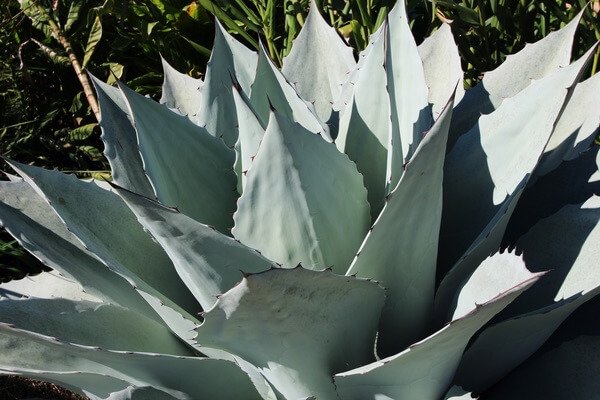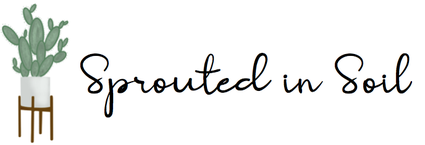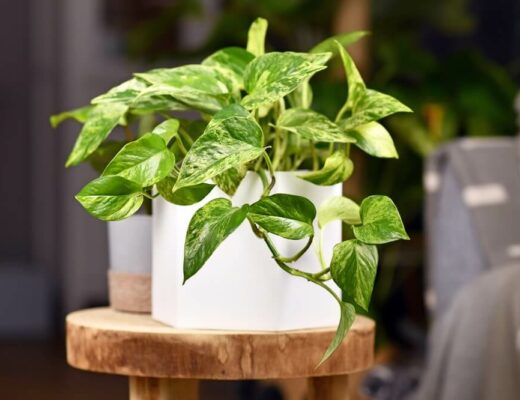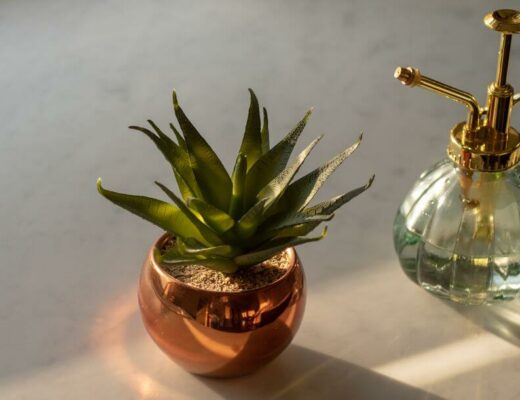When people think of succulents and cacti, they usually associate these plants with dry, hot deserts or warm coastal beaches. It may surprise you that there are a lot of varieties that actually do great in cold weather climates. There are cold-hardy succulents that thrive in places that receive heavy snowfall in winter!
In the United States, we use the USDA Plant Hardiness Zone Map as a way to help gardeners choose which plants will grow best outside in a specific geographical location. Hardiness zones are distinct geographical areas based on the average low temperatures. Temperature is one of the biggest factors in plant survival so this system helps categorize what can be planted and where.
The drawback to this zone map is that it only takes into consideration the temperatures. It does not include other factors that are vital to a plants survival such as precipitation, sun, humidity, wind or altitude. So when you are looking for cold tolerant succulents and cacti that will survive harsh winters, be sure to do some research into these other factors.
This post provides a great list of 21 succulents for cold weather that will get you well on your way to having a beautiful outdoor garden!
1. Sedum dasyphyllum

Hardiness Zone: 7a (cold-hardy to 0°F)
You may recognize this charming ground cover by its other names, Corsican stonecrop or Sedum burnatii. Despite its succulent, fat jelly bean like leaves, this succulent is frost hardy and is a great succulent for cold weather. It enjoys full sun but can tolerate partial shade.
S. dasyphyllum spreads quickly and is low growing. This succulent will create a beautiful turquoise-silver carpet that changes to a lavender-pink when exposed to direct sun. Plant in shallow, rocky ground or in a hanging basket and watch it cascade from up high.
2. Sempervivum arachnoideum ‘Cebenese’

Hardiness Zone: Zone 5 (cold-hardy to -20°F)
Also known as the Cobweb Houseleek, you may have a guess as to what this plant looks like. The leaves are a lime green with frosted burgundy tips that are covered in a fine, white webbing. This is not only a cold-hardy succulent but does just fine buried under feet of snow!
The rosette shaped mature plants produce small round offsets that shoot up on stolons. These new plants surround the mature plant and look like lollipops on a stick. As the new S. arachnoideum grows, the rosettes begin to open.
3.Sedum sieboldii ‘October Daphne’

Hardiness Zone: Zone 5 (cold-hardy to -20°F)
This is a sweet, low growing, cold-hardy sedum that grows in a tall rosette up to approximately one foot tall. The leaves are a light silver green edged in a glowing pink. Delicate pink flowers that look like stars bloom beginning in late summer. Because of their sweetness, hummingbirds and bees are frequently seen feeding from the ‘October Daphne’s’ flowers.
Despite its delicate look, this succulent is cold-hardy and can stand up to harsh snow and frost. S. sieboldii does well in both full sun and partial shade.
4. Sedum spurium ‘Dragon’s Blood’

Hardiness Zone: Zone 4 (cold-hardy to -30°F)
‘Dragon’s Blood’ is a dense, carpet forming sedum with light green leaves with burgundy margins. It is drought tolerant so should be planted in the ground with a soil mixture that is well draining and should not be overwatered.
Planting ‘Dragon’s Blood’ in full sun will encourage the leaves to keep the deep burgundy edges. Ruby colored flowers bloom in the summer attracting pollinators. Despite being attractive to bees and hummingbirds, ‘Dragon’s Blood’ is both deer and rabbit resistant.
5. Opuntia ‘Pina Colada’

Hardiness Zone: 5a (cold-hardy to -20°F)
How cool is it that some cacti are cold and even frost hardy. Remember that all cacti are succulents! Opuntia ‘Pina Colada’ is one of these frost hardy cacti that grows tall and bushy. It loves to receive about six hours of full sun per day. This sun exposure is especially needed if you want to witness its breathtaking blooms.
The wide leaves look like flat paddles or pancakes. The leaves do have prickly spines so be careful when handling them! Expect wide, cup shaped flowers that change from yellow to pink.
Opuntia ‘Pina Colada’ does prefer drier ground so does really well in drier climates that still see below freezing temperatures. If you are in a state that receives a large amount of snowfall, consider planting in a garden that is sandy and gritty. This cactus does not like to be overly wet. It also doesn’t do well with long exposure to harsh, cold winds so it’s important to plant outside in a protected area.
6. Sedum japonicum ‘Tokyo Sun’

Hardiness Zone: 8 (cold-hardy to 10°F)
Another cold-hardy sedum that tolerates winters is the Sedum japonicum ‘Tokyo Sun’, however it is not as cold-hardy as some other varieties. The small orzo shaped leaves range from a neon lime green to a bright golden yellow.
‘Tokyo Sun’ is a low growing, creeping perennial succulent that does well in full sun and partial shade and of course is one of the great cold weather succulents. If planted in partial shade, you will likely notice the yellow leaves become a faded green.
This cold-hardy succulent is great used as decorative ground cover as it self propagates and spreads quickly. Watch out for the golden blooms in the summer months.
7. Delosperma Jewel of Desert ‘Garnet’

Hardiness Zone: 6 (cold-hardy to -10°F)
With lime green, pickle shaped leaves, this succulent’s flowers dazzle! The flowers are round with numerous thin leaves. They put on a colorful show with hot pink on the tips changing to purple with a white center.
As with all Delosperma, this cold-hardy winter succulent grows quickly and can take over an area of your garden in the blink of an eye. It is great used as ground cover and a fine way to cover up unsightly areas in your yard!
8. Sempervivum ‘Hedgehog’
Hardiness Zone: 5 (cold-hardy to -20°F)
The aptly named Sempervivum ‘Hedgehog’ propagates easily as the new pups sprout on such delicate stolons that they quickly break and the new plants literally roll to a new area and take root. This cold-hardy succulent has bright green pointy leaves tipped in burgundy that grow in a tight rosette form.
Avoid overwatering the S. ‘Hedgehog’ and don’t plant in an area that has frequent standing water.
9. Euphorbia rigida

Hardiness Zone: 7 (cold-hardy to 0°F)
Also known as the Gopher Spurge or Upright Myrtle Spurge, this fascinating flowering succulent has upright growing stems with thin, blade-like leaves. The stems and leaves are a blue-green. Chartreuse flowers top these magnificent stems in the spring.
Not only is this a great outdoor succulent that tolerates colder climates, it is also very resilient to pests, animals and disease. E. rigida requires minimal care. As long as it is planted in a garden with rocky soil that receives full sun, your Euphorbia rigida will be happy!
10. Sedum spurium ‘John Creech’

Hardiness Zone: 3a (cold-hardy to -40°F)
Another fabulous cold-hardy outdoor succulent is the S. spurium ‘John Creech’, named after the man who discovered this plant. This more rare cold-hardy sedum has green scalloped leaves that are cupped. It grows quickly into a dense carpet and is great at stifling weed growth.
Reaching only two inches tall, ‘John Creech’ does well in full sun and partial shade so can be planted in a variety of areas in your garden. Look out for the pink flowers that bloom in the early fall. It is a cold weather succulent that does very well in even the bitterest of climates and always comes back looking impeccable in the spring.
11. Agave ovatifolia ‘Whale’s Tongue’

Hardiness Zone: 7 (cold-hardy to 0°F)
While not as cold-hardy as some of the other extremely cold tolerant succulents in this list, the Agave ovatifolia or ‘Whale’s Tongue’ tolerates temperatures down to 5°F. Reaching a mature height of three feet tall, this agave has reaching, light green-silver leaves that bend away from the center rosette.
This hardy outdoor succulent is a great addition to a rock garden and a way to bring a desert feel to more northern areas.
12.Sedum ‘Lime Twister’

Hardiness Zone: 4 (cold-hardy to -30°F)
Sedum ‘Lime Twister’ is a two toned, variegated cold-hardy succulent. It has light green leaves with creamy yellow margins. This succulent blooms in late summer to early fall, showing off baby pink flowers that bloom for more than one month!
‘Lime Twister’ is a hardy outdoor succulent resistant to deer and rabbits. It has very few needs. It does great in any type of soil and readily self propagates and spreads.
13. Hesperaloe parviflora

Hardiness Zone: 5 (cold-hardy to -20°F)
Also called the ‘Red Yucca’, the Hesperaloe parviflora is not a yucca at all but does produce long, slender leaves that resemble those of a yucca plant. With a similar appearance to a decorative tall grass, this cold-hardy succulent reaches a height of three feet.
In colder climates, beautiful coral flowers bloom in late spring to early summer on long arching stems and attract hummingbirds. The green leaves turn a purplish-red in the fall and winter months.

While the Hesperaloe parviflora is a cold-hardy succulent, it does require extremely well draining soil and does best in rocky, sandy soils. They are very drought hardy as well so do not like very wet climates.
14. Sedum album ‘Coral Carpet’

Hardiness Zone: 4 (cold-hardy to -30°F)
This cold-hardy sedum has cute, tiny bead-like leaves that change from green to a rich coral red when exposed to ample amounts of direct sunlight. ‘Coral Carpet’ is a low growing succulent for cold weather climates that is a perfect choice for use as ground cover or a green roof!
15. Sempervivum calcareum

Hardiness Zone: 5 (cold-hardy to -20°F)
This lovely cold-hardy succulent comes from the high altitudes of the French Alps. It has wide, flat blue-green leaves with pointy reddish-purple tips. Like all sempervivum, the leaves are bordered with tiny, fine hairs.
Sempervivum calcareum does well in climates with wet, cold winters, unlike other varieties of sempervivum which like more dry winters.
16. Rosularia muratdaghensis

Hardiness Zone: 3 (cold-hardy to -40°F)
R. muratdaghensis is a cold weather succulent from the Himalayan Mountains closely resembles sempervivum but is actually closely related to the genus kalanchoe. This cold-hardy succulent is small and dainty. The leaves form tight rosettes and they grow in a mounding or clumping pattern.
Because of their small roots, R. muratdaghensis can grow just about anywhere, even in the cracks and crevices of retaining walls.
17. Opuntia ‘Desert Skies’

Hardiness Zone: 6 (cold-hardy to -10°F)
A surprisingly cold-hardy succulent, Opuntia ‘Desert Skies’ does just fine under a layer of snow! This cactus loves full sun and grows quickly (over twelve feet tall!) in the spring and summer months, readily producing new, flat paddle-shaped leaves.
This cactus has large, feathery pink blooms surrounding numerous yellow stamens. While Opuntia ‘Desert Skies’ is a hard cactus to kill, it does need to be protected from heavy rains and standing water.
18. Orostachys malacophylla var. Iwarenge ‘Chinese Dunce Cap’

Hardiness Zone: 6 (cold-hardy to -10°F)
Much more known for its common name of ‘Chinese Dunce Cap’ rather than its long scientific name, this cold-hardy succulent has silver-lavender soft leaves. New offsets grow from the mature rosette from long stolons making it great to plant as a cascading feature over walls or fences.
In the winter snows, the entire above ground portion of the plant dies back only to reemerge in the spring.
19. Sedum spathulifolium ‘Cape Blanco’

Hardiness Zone: 6 (cold-hardy to -10°F)
Not only is S. spathulifolium ‘Cape Blanco’ an extremely cold tolerant succulent, it also does well in moist areas! This succulent boasts silvery green leaves with a fine white powdery finish. In the winter, the leaves turn a bright magenta! Pollinators love the yellow blooms that flower in the summer months.
20. Delosperma cooperi

Hardiness Zone: 6 (cold-hardy to -10°F)
Also known as the Trailing Ice Plant, the beautiful D. cooperi has small banana shaped green leaves that flush a dusty purple in cooler weather. The long lasting blooms are a lively magenta color that open during the days and close at night.
This low growing, hardy outdoor succulent is cold tolerant and can be grown as ground cover to create an alluring green and magenta carpet, or can be grown up retaining walls!
21. Sempervivum ‘Red Lion’

Hardiness Zone: 5 (cold-hardy to -20°F)
S. ‘Red Lion’ needs lots of bright, direct sunlight in order to maintain its burgundy red leaves. Like all Sempervivum, the cold-hardy ‘Red Lion’ grows in a right rosette shape and readily produces offsets, creating a beautiful spread.
This is a perfect perennial succulent for cold weather. It is resilient to hard frosts and maintains the beautiful blush throughout the year.
Wrapping Up
I hope you enjoyed this list of cold-hardy succulents that do well when grown outside in regions that receive cold winters! Remember to take into account other factors such as precipitation, humidity, sun, wind and altitude into consideration when deciding which succulents and cacti to plant outside.
So now that you know there are numerous succulents for cold weather, many of which are perennial succulents, and that they are cold-hardy, go out and shop!




